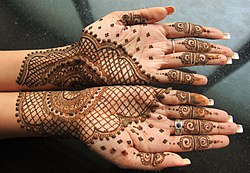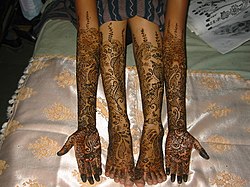Mehndi
Mehndi is a form of body art and temporary skin decoration usually drawn on hands or legs, in which decorative designs are created on a person's body, using a paste, created from the powdered dry leaves of the henna plant (Lawsonia inermis). It is a popular form of body art among the women of India, Bangladesh, Pakistan, Nepal, Iran, Maldives, and the Muslim population of Sri Lanka, and resembles similar practices found in North Africa and the Middle East. This kind of body art is called Mehndi Design in India, Pakistan, Bangladesh and Nepal. Whereas, in West it is called Henna Designs.[1]
According to a 2013 study, henna has been used as a dye for the skin (as well as the hair and nails) for more than 4,000 years.[2]
According to A Dictionary of Urdu, Classical Hindi and English Mehndi also refers to "the marriage-feast on the occasion of the bride's hands and feet being stained with henna (ḥinā)" or "an ark, or tabernacle, carried in solemn procession by some Muslims on the eve of the anniversary of the death of a person who died just as he was about to marry:—meṅhdī bāṅdhnā (-meṅ)."[3] It was originally used for only women's palms and sometimes for men, but as time progressed, it was more common for women to wear it[citation needed].
There are many variations and designs. Women usually apply mehendi designs to their hands and feet, though some, including cancer patients and women with alopecia occasionally decorate their scalps.[4] The standard color of henna is brown, but other design colors such as white, red, black and gold are sometimes employed.[4]
Mehendi in Indian tradition is typically applied during Hindu weddings and festivals like Karva Chauth, Vat Purnima, Diwali, Bhai Dooj, Navraathri, Durga Pooja and Teej. Muslims in South Asia also apply mehendi during Muslim weddings, festivals such as Eid-ul-Fitr and Eid-ul-Adha.
In Hindu festivals, many women have Henna applied to their hands and feet and sometimes on the back of their shoulders too, as men have it applied on their arms, legs, back, and chest. For women, it is usually drawn on the palm, back of the hand and on feet, where the design will be clearest due to contrast with the lighter skin on these surfaces, which naturally contain less of the pigment melanin.
Alta, Alata, or Mahur is a red dye used similarly to henna to paint the feet of the brides in some regions of the South Asia, for instance in Bangladesh and Indian States of West Bengal.
Likely due to the desire for a "tattoo-black" appearance, some people add the synthetic dye p-Phenylenediamine (PPD) to henna to give it a black colour. PPD may cause severe allergic reactions and was voted Allergen of the Year in 2006 by the American Contact Dermatitis Society.
Etymology[edit]
Origin of the word is from Sanskrit word Mendhika.[5]
Origins[edit]
The use of mehndi is first documented in Ancient Egypt as a decorative purpose for mummies.[citation needed] The use of mehndi as decorative art was prevalent in fourth century India, which is evident from cave art in the Deccan, specifically in the Ajanta Caves.[6]
Tradition[edit]
Mehndi is a ceremonial art form common in India, Pakistan, Bangladesh and Nepal. It is typically applied during weddings - for Sikh, Muslim and Hindu brides. In Rajasthan, the grooms are given designs that are often as elaborate as those for brides. In Assam, apart from marriage, it is broadly used by unmarried women during Rongali bihu.
Muslims in Afghanistan also use it.
Process[edit]
Mehndi paste is usually applied to the skin using a plastic cone, a paintbrush or a stick. After about 15–20 minutes, the mud will dry and begin to crack, and during this time, a mixture of lemon juice and white sugar can be applied over the henna design to remoisten the henna mud so that the henna will stain darker. The painted area is then wrapped with tissue, plastic, or medical tape to lock in body heat, creating a more intense colour on the skin. The wrap (not a traditional method), is worn for two to six hours, or sometimes overnight, and then removed. When first removed, the henna design is pale to dark orange in colour and gradually darkens through oxidation, over the course of 24 to 72 hours. The final color is reddish brown and can last anywhere from one to three weeks depending on the quality and type of henna paste applied, as well as where it was applied on the body (thicker skin stains darker and longer than thin skin). Moisturizing with natural oils, such as olive, sesame seed, or coconut, will also help extend the lifetime of the stain. Skin exfoliation causes the henna tattoo to fade.[7][8]
In weddings[edit]
Example of a wedding tradition[edit]
The Mehndi, a dye produced from a mehndi plant, would be delivered by the groom's relatives on a silver tray containing two burning candles.[9][10] Before the application of the henna, the guests would throw coins over the bride's head as a symbol of fertility. Then, the bride's soon to be mother-in-law would then bring out a piece of silk cloth as a gift to the bride. The bride would then walk along the unrolled piece of silk cloth in the direction of her future mother-in-law and kiss her hand.
Once this is done, fruits, nuts, and pastries would be brought out and songs would be sung in hopes of making the bride cry. This was done because it was thought that the bride's crying would bring good luck. The bride would then sit on a cushion while her mother-in-law placed a gold coin in her hand as another sign of good luck. Once the bride was given the gold coin, the henna would be applied.
The person who applied the henna was always someone who was already known to be happily married; that person would apply the henna onto the bride's palms, fingers, and toes. The henna was made from dried henna leaves, and the process of application took a long time. For this reason, it was suggested that it be applied between thirty-two and forty-eight hours before the wedding so that it may have enough time to stain the skin. In addition to the bride, most women at the mehndi ceremony also apply the henna to their hands for aesthetics.
See also[edit]
References[edit]
- ↑ "mehndi-designs". Retrieved April 30, 2021.
- ↑ Sarkar, Kalyani (2020-10-04). "A Cultural History of Mehndi and Henna Designs". PsychNewsDaily. Retrieved 2021-06-16.
- ↑ A dictionary of Urdu, classical Hindi, and English. Dsal.uchicago.edu. Retrieved on 2011-09-26.
- ↑ 4.0 4.1 "The next big thing on Eid is white mehndi, and I tried it - Style - Images". Images.dawn.com. 24 June 2017. Retrieved 2019-04-30.
- ↑ Stevenson, Angus; Waite, Maurice (2011-08-18). Concise Oxford English Dictionary: Luxury Edition. OUP Oxford. p. 890. ISBN 978-0-19-960111-0.
- ↑ International, Aroha (2017-10-01). "History, Origin & Cultural Significance of Henna". Aroha International. Retrieved 2021-05-27.
- ↑ Khadijas henna body art recipe
- ↑ How to Apply Henna Tattoo Paste
- ↑ "The Beautiful and Intricate Application of Bridal Henna". The Spruce. Retrieved 19 August 2018.
- ↑ "Henna Party". www.turkishculture.org. Retrieved 19 August 2018.




